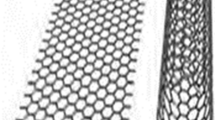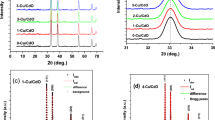Abstract
Some physicochemical properties of homogeneous and heterogeneous films formed by Au and Cu nanoparticles on graphite are studied by scanning tunneling microscopy and spectroscopy. It is found that the nanoparticles have a shape close to spherical with a diameter of 3‒6 nm, the gold particles do not contain impurities, and the copper particles can be coated with oxide. The adsorption properties of nanostructured coatings with respect to hydrogen, carbon oxide, and oxygen are determined. Copper oxide is reduced by carbon oxide and hydrogen, but the latter is also adsorbed onto oxide-free copper particles and gold. Exposure to oxygen results in the reformation of the oxide on copper. The possibility of rearranging the electronic structure of copper nanoparticles during hydrogen adsorption is confirmed by the results of quantum chemical simulation.







Similar content being viewed by others
REFERENCES
D. Kim, J. Resasco, Y. Yu, A. M. Asiri, and P. D. Yang, “Synergistic geometric and electronic effects for electrochemical reduction of carbon dioxide using gold–copper bimetallic nanoparticles,” Nat. Commun. 5, 4948–4956 (2014).
S. Neatu, J. A. Macia-Agullo, P. Concepcion, and H. Garcia, “Gold–copper nanoalloys supported on TiO2 as photocatalysts for CO2 reduction by water,” J. Am. Chem. Soc. 136, 15969–15976 (2014).
R. He, Y. C. Wang, X. Y. Wang, Z. Wang, G. Liu, W. Zhou, L. Wen, Q. Li, X. Wang, X. Chen, J. Zeng, and J. G. Hou, “Facile synthesis of pentacle gold–copper alloy nanocrystals and their plasmonic and catalytic properties,” Nat. Commun. 5, 4327–4337 (2014).
C. L. Bracey, P. R. Ellis, and G. J. Hutchings, “Application of copper-gold alloys in catalysis: current status and future perspectives,” Chem. Soc. Rev. 38, 2231–2243 (2009).
T. Pasini, M. Piccinini, M. Blosi, R. Bonelli, S. Albonetti, N. Dimitratos, J. A. Lopez-Sanchez, M. Sankar, Q. He, C. J. Kiely, G. J. Hutchings, and F. Cavani, “Selective oxidation of 5-hydroxymethyl-2-furfural using supported gold-copper nanoparticles,” Green Chem. 13, 2091–2099 (2011).
C. Della Pina, E. Falletta, and M. Rossi, “Highly selective oxidation of benzyl alcohol to benzaldehyde catalyzed by bimetallic gold–copper catalyst,” J. Catal. 260, 384–386 (2008).
J. C. Bauer, G. M. Veith, L. F. Allard, Y. Oyola, S. H. Overbury, and S. Dai, “Silica-supported Au-CuOx hybrid nanocrystals as active and selective catalysts for the formation of acetaldehyde from the oxidation of ethanol,” ACS Catal. 2, 2537–2546 (2012).
J. Llorca, M. Dominguez, C. Ledesma, R. J. Chimentão, F. Medina, J. Sueiras, I. Angurell, M. Seco, and O. Rossell, “Propene epoxidation over TiO2-supported Au–Cu alloy catalysts prepared from thiol-capped nanoparticles,” J. Catal. 258, 187–198 (2008).
L. Wang, Y. Zhong, H. Jin, D. Widmann, J. Weissmuller, and R. J. Behm, “Catalytic activity of nanostructured Au: scale effects versus bimetallic/bifunctional effects in low-temperature CO oxidation on nanoporous Au,” Beilstein J. Nanotechnol. 4, 111–128 (2013).
X. Liu, A. Wang, L. Li, T. Zhang, C.-Y. Mou, and J.-F. Lee, “Synthesis of Au–Ag alloy nanoparticles supported on silica gel via galvanic replacement reaction,” J. Catal. 278, 288–296 (2011).
S. Dutta, C. Ray, S. Sarkar, M. Pradhan, Y. Negishi, and T. Pal, “Silver nanoparticle decorated reduced graphene oxide (RGO) nanosheet: a platform for SERS based low-level detection of uranyl ion,” Electrochem. Acta 180, 1075–1084 (2015).
General Principles and Applications to Clean and Absorbate-Covered Surfaces, Ed. by H.-J. Guntherodt and R. Wiesendanger (Springer, Berlin, 1992).
G. Binnig, H. Rohrer, C. Berber, and E. Weibel, “Tunneling through a controllable vacuum gap,” Appl. Phys. Lett. 40, 178–180 (1981).
E. Meyer, H. J. Hug, and R. Bennewitz, Scanning Probe Microscopy (Springer, Berlin, 2004).
R. J. Hamers and Y. J. Wang, “Atomically-resolved studies of the chemistry and bonding at silicon surfaces,” Chem. Rev. 96, 1261–1290 (1996).
R. J. Hamers, R. M. Tromp, and J. E. Demuth, “Surface electronic structure of Si (111)-(7 × 7) resolved in real space,” Phys. Rev. Lett. 56, 1972–1975 (1986).
A. K. Gatin, M. V. Grishin, S. Yu. Sarvadii, and B. R. Shub, “Interaction of gaseous reagents on gold and nickel nanoparticles,” Russ. J. Phys. Chem. B 12, 317–324 (2018).
M. V. Grishin, A. K. Gatin, N. V. Dokhlikova, A. A. Kirsankin, A. I. Kulak, S. A. Nikolaev, and B. R. Shub, “Adsorption and interaction of hydrogen and oxygen on the surface of separate crystalline gold nanoparticles,” Kinet. Catal. 56, 532–539 (2015).
T. Ozaki, “Variationally optimized atomic orbitals for large-scale electronic structures,” Phys. Rev. B 67, 155108 (2003).
P. Giannozzi, S. Baroni, N. Bonini, M. Calandra, R. Car, C. Cavazzoni, D. Ceresoli, G. L. Chiarotti, M. Cococcioni, I. Dabo, A. Dal Corso, S. de Gironcoli, S. Fabris, G. Fratesi, R. Gebauer, et al., “QUANTUM ESPRESSO: a modular and open-source software project for quantum simulations of materials,” J. Phys.: Condens. Matter 21, 395502 (2009).
M. Heinemann, B. Eifert, and C. Heiliger, “Band structure and phase stability of the copper oxides Cu2O, CuO, and Cu4O3,” Phys. Rev. B 87, 115111 (2013).
B. K. Meyer, A. Polity, D. Reppin, M. Becker, P. Hering, P. J. Klar, Th. Sander, C. Reindl, J. Benz, M. Eickhoff, C. Heiliger, M. Heinemann, J. Bläsing, A. Krost, S. Shokovets, C. Müller, and C. Ronning, “Front cover: binary copper oxide semiconductors: from materials towards devices,” Phys. Status Solidi B 249, 1487–1647 (2012).
J. Ghijsen, L. H. Tjeng, J. van Elp, H. Eskes, J. Westerink, G. A. Sawatzky, and M. T. Czyzyk, “Electronic structure of Cu2O and CuO,” Phys. Rev. B 38, 11322–11330 (1988).
F. P. Koffyberg and F. A. Benko, “A photoelectrochemical determination of the position of the conduction and valence band edges of p-type CuO,” J. Appl. Phys. 53, 1173–1177 (1982).
F. Marabelli, G. B. Parravicini, and F. Salghetti-Drioli, “Optical gap of CuO,” Phys. Rev. B 52, 1433–1436 (1995).
J. F. Pierson, A. Thobor-Keck, and A. Billard, “Cuprite, paramelaconite and tenorite films deposited by reactive magnetron sputtering,” Appl. Surf. Sci. 210, 359–367 (2003).
F. I. Dalidchik, S. A. Kovalevskii, and A. V. Kovytin, “Atomic and electronic structure of surface nanoscale graphite structures,” Khim. Fiz. 23 (7), 83–90 (2004).
A. di Benedetto, G. Landi, and L. Lisi, “Improved CO-PROX performance of CuO/CeO2 catalysts by using nanometric ceria as support,” Int. J. Hydrogen Energy 42, 12262–12275 (2017).
E. A. Goldstein and R. E. Mitchell, “Chemical kinetics of copper oxide reduction with carbon monoxide,” Proc. Combust. Inst. 33, 2803–2810 (2011).
Y. Bu, S. Er, J. W. Niemantsverdriet, and H. O. A. Fredriksson, “Preferential oxidation of CO in H2 on Cu and Cu/CeOx catalysts studied by in situ UV-vis and mass spectrometry and DFT,” J. Catal. 357, 176–187 (2018).
J. Y. Kim, J. A. Rodriguez, J. C. Hanson, A. I. Frenkel, and P. L. Lee, “Reduction of CuO and Cu2O with H2: H embedding and kinetic effects in the formation of suboxides,” J. Am. Chem. Soc. 125, 10684–10692 (2003).
J. Harris and A. Liebsch, “On the physisorption interaction of H2 with Cu-metal,” Phys. Scr. 4, 14–16 (1983).
T. Caputo, L. Lisi, R. Pirone, and G. Russo, “On the role of redox properties of CuO/CeO2 catalysts in the preferential oxidation of CO in H2-rich gases,” Appl. Catal., A 348, 42–53 (2008).
L. Rout, A. Kumar, R. S. Dhaka, G. N. Reddy, S. Giri, and P. Dash, “Bimetallic Au-Cu alloy nanoparticles on reduced graphene oxide support: synthesis, catalytic activity and investigation of synergistic effect by DFT analysis,” Appl. Catal., A 538, 107–122 (2017).
J. Han, Y. Zahou, Y.-Q. Chai, L. Mao, Y.-L. Yuan, and R. Yuan, “Highly conducting gold nanoparticles-graphene nanohybrid films for ultrasensitive detection of carcinoembryonic antigen,” Talanta 85, 130–135 (2011).
J. Wang, J. Li, A. J. Baca, J. Hu, F. Zhou, W. Yan, and D. W. Pang, “Amplified voltammetric detection of DNA hybridization via oxidation of ferrocene caps on gold nanoparticle/streptavidin conjugates,” Anal. Chem. 75, 3941–3945 (2003).
W. Zhan, J. Wang, H. Wang, J. Zhang, X. Liu, P. Zhang, M. Chi, Y. Guo, Y. Guo, G. Lu, S. Sun, S. Dai, and H. Zhu, “Crystal structural effect of AuCu alloy nanoparticles on catalytic CO oxidation,” J. Am. Chem. Soc. 139, 8846–8854 (2017).
N. V. Dokhlikova, N. N. Kolchenko, M. V. Grishin, A. K. Gatin, and B. R. Shub, “Substrate effect on hydrogen adsorption on gold cluster,” Nanotechnol. Russ. 11, 735–742 (2016).
ACKNOWLEDGEMENTS
This work was supported by the Russian Science Foundation, project no. 18-73-00195. The resources of the Interdepartmental Supercomputer Center of the Russian Academy of Sciences were used in the calculations.
Author information
Authors and Affiliations
Corresponding author
Additional information
Translated by V. Kudrinskaya
Rights and permissions
About this article
Cite this article
Gatin, A.K., Grishin, M.V., Dokhlikova, N.V. et al. Adsorption Properties of the Film Formed by Gold and Copper Nanoparticles on Graphite. Nanotechnol Russia 13, 453–463 (2018). https://doi.org/10.1134/S1995078018050063
Received:
Accepted:
Published:
Issue Date:
DOI: https://doi.org/10.1134/S1995078018050063




